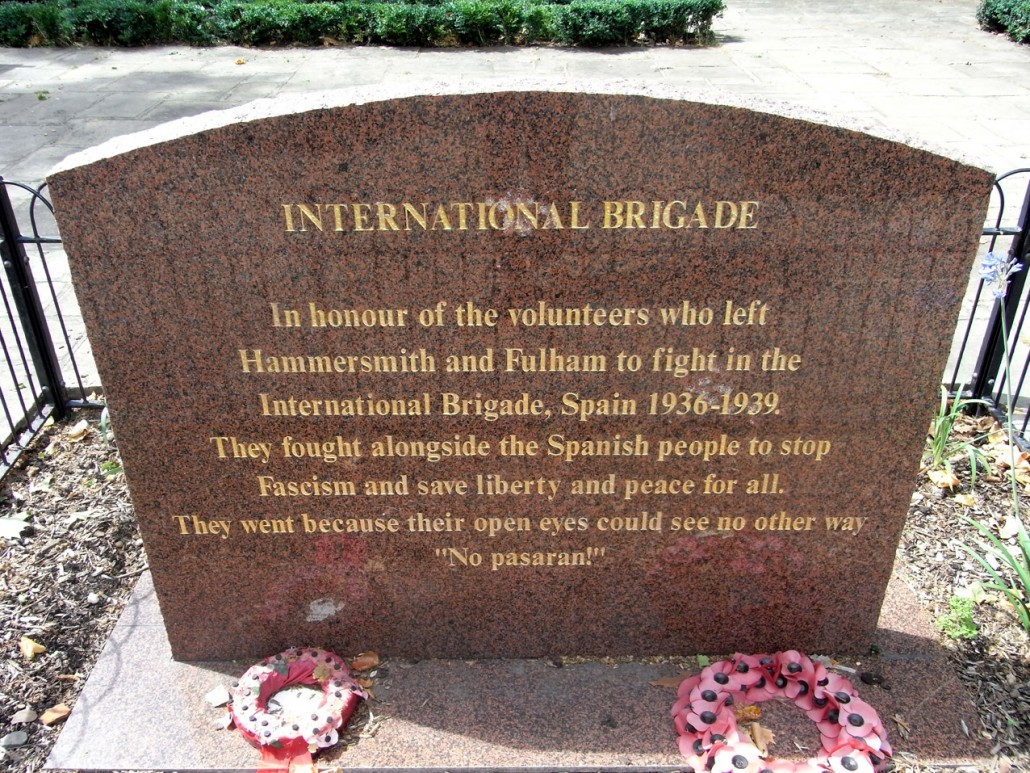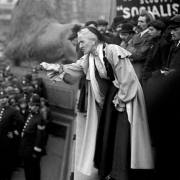MONTHLY BLOG 58, LIVING INTENSELY IN THE EYE OF THE STORM: WHY DO PEOPLE QUIT THEIR DAILY LIVES AND GO TO JOIN CRUSADES IN DISTANT LANDS?
If citing, please kindly acknowledge copyright © Penelope J. Corfield (2015)
My previous BLOG/ 57 wrote about political leaders who might hope to ride and direct the tides of History.1 But it’s not only leaders. Historical outcomes are the sum of all the actions and inactions of everybody, combined together. We don’t all have the same power to direct. Yet everybody plays some part, even if by way of abstention. Hence we can all try, if we want, to change the roles which might seem allocated to us. It’s not a very simple thing to do, certainly. As is well known, it’s much easier to make good resolutions than to achieve them. Furthermore, good intentions can also, proverbially, achieve the reverse of the effect intended. Yet things can, upon occasion, be very different.
This BLOG is about the motivations of people who make dramatic changes, quitting their daily lives and going to join crusades in distant lands. Obviously the precise combination of reasons varies from individual to individual. There are usually strong ‘push’ factors, impelled by dissatisfaction with daily life at home. At the same time, however, there’s generally one or more strong ‘pull’ factor as well, attracting via the appeal of a distant cause that’s on the side of History.
Political commitment can have that effect. The thousands of left-wingers from across the world (and especially across Europe), who went in the 1930s to fight for the International Brigades in the Spanish Civil War, were a case in point.2 They were attracted by the lure of action, as well as by their support for Spain’s democratic government. Many were communists. Even if not drilled in the niceties of Marxist theory, they were accustomed to thinking of their own great cause as marching inevitably through History towards a triumphant outcome.
|
Fig. 1. Memorial to Hammersmith & Fulham volunteers, who fought for the International Brigades in Spain, 1936-9 – installed in Fulham Palace Gardens SW6 in 1997. |
The fact that the great cause of anti-Fascism needed an urgent helping hand was not an obstacle. For the many communists in the International Brigades their commitment was encouraged by the Marxist analysis of History, which saw the processes of change as a constant struggle. Of course, there is always opposition and conflict. But it is precisely through complex conflicts that fundamental change will emerge.3 Thus the role of struggle, if need be in the form of real fighting, was not an impediment for those of high spirits and with an active temperament. Religious motivations are even more common in calling people to action. What can be more powerful and exhilarating than fighting, either literally or symbolically, in God’s cause? It is not even necessary to be highly spiritual to heed that message. It is the call to action which is the lure, with the double promise of fighting in the winning cause of righteousness and, while so doing, of gaining divine goodwill. The rewards, whether spiritual or this-worldly (or both), will follow. It’s a high promise which provides sustenance through the possible times of loneliness, boredom, and confusion which often afflict people who are uprooted from their homes. Indeed, the promise of divine reward encourages those seriously dissatisfied with their current life to take drastic action to put things right.
Particularly electrifying in religious motivation is the call to action that comes when ‘the End is Nigh’. Generally, people muddle on from day to day without worrying about long-term trends. But religious teachings, particularly those which view History as a linear journey from the creation of the world to the last judgment, provide such a mental framework. There was a beginning. There will be an ending, often after a phase of apocalyptic upheaval and turmoil, when God’s final judgment will be revealed.
Believers should accordingly be prepared. They might also look, anxiously or eagerly as the case might be, for signs of the imminent unfolding of these great events. All attempts at second-guessing divine intentions have been consistently discouraged by orthodox religious leaders in all the great linear faiths. Nonetheless, predictions of the imminent End of the World recur in every generation, and especially in times of turmoil.4 The message, for believers, is intensely exciting and empowering.5 It overshadows all routine matters. And heeding the call provides a chance for changing lifestyles. It encourages some to leave home to follow a special teacher or leader. It sometimes leads to violence, when believers fight against unbelievers. And it can even result in mass suicides/murders, if embattled cultists decide to take their own lives and those of their young.
These were all dramatic ways of ‘bearing witness’, to alert an unbelieving world. One non-violent move was undertaken by an aristocratic English lady named Lady Hester Stanhope (1776-1839). In her youth, she had a busy social life, becoming hostess for her unmarried uncle, the Prime Minister William Pitt the Younger. But, with his death, she lost her role. What to do? She travelled in the Near East, causing a sensation among the Bedouins when visiting Palmyra. She dressed in an exoticised eastern costume, with a turban and Turkish slippers (see Fig.2). And, above all, in 1810 she announced that the End was nigh; that the Messiah would soon return to the Holy Lands; and that she would be waiting. Which she did. She lived for the next 29 years until her death in Sidon (on the Lebanon coast), at first in grand style, later in desperate poverty, still waiting.6
|
Fig. 2 Lady Hester Stanhope, in her own version of oriental garb, who lived in Lebanon, for almost thirty years, awaiting the return of the Messiah and the Last Judgment. |
Stanhope’s experience, extraordinary as it was for a woman of her social class, was nonetheless a classic example of what can happen when an apocalyptic vision is not immediately realised. Generally, dashed hopes turn into disillusionment. Ordinary life resumes. Yet not always. Sometimes, people turn to dogged waiting. In Stanhope’s case, she left no cult behind her. Indeed, she may have realised, by the end of her life, that her hopes had been in vain. Nonetheless, she probably found consolation in the sheer pertinacity of her waiting. And that’s what can happen, not just for individuals but across generations. A group of followers can take up the cause, even after the leader has died, not only waiting but also recruiting successors to hand down the message through time.
In England, the Muggletonians survived from the mid-seventeenth to the mid-twentieth centuries.7 Their views were kept in semi-secrecy, circulated only between families and close friends. Others, by contrast, wait in full public view. The Seventh-Day Adventist church was founded in the aftermath of the ‘Great Disappointment’ of October 1844, when the world was supposed to end but didn’t. An American group, initially known as Millerites after the first prophet William Miller, decided to continue waiting, Today the huge movement, renamed as Seventh-Day Adventist, has millions of adherents world-wide.8
Three comments to conclude. Firstly, the confidence that one is fighting, whether literally or symbolically, on the side of History and/or God is individually empowering, especially when worldly as well as other-worldly hopes/grievances are intertwined. Such beliefs can get people to do surprising things. For those without any previous certitudes, moreover, doing something drastic can seem the best way of gaining new faith through action.
Secondly, the force of such beliefs may be creative and affirmative, but may also unleash powers of destruction, especially when encountering opposition. Because the stakes are so high, so are the passions.
Lastly, curbing a militant commitment to fighting on the side of God or history is not easy. The main antidote is disillusionment, when the euphoria fades. Yet that can take a long time. Hence the secular authorities, generally cautious in matters of private belief, may intervene in cases of violence or potential violence. Currently, various governments are running ‘deradicalisation’ programmes, seeking to get militant Islamists to renounce armed struggle and/or to prevent others from joining them. That can’t be simply done, however, by flatly opposing the great cause. The empowering and exhilarating nature of commitment needs full acknowledgement. Only then, can it potentially be diverted into an alternative re-empowerment, in the cause of everyday, not apocalyptic, action. Different outlets for strong energies – calmer ways of navigating the tides of history.
1 See P.J. Corfield, ‘Riding the Tides of History: Why is Jeremy Corbyn like Napoleon Bonaparte?’ BLOG/57 (Sept. 2015).
2 Details in K. Bradley, International Brigades in Spain, 1936-9 (1994); A. Castells, Las brigadas internacionales de la Guerra di España (Barcelona, 1974); and M.W. Jackson, Fallen Sparrows: The International Brigades in the Spanish Civil War (Philadelphia, 1995).
3 See G.A. Cohen, Karl Marx’s Theory of History: A Defence (Oxford, 1978).
4 See listings in www.en.wikipedia.org/wiki/List_of_dates_predicted_for_apocalyptic_events; and discussions in E. Weber, Apocalypses (Cambridge, Mass., 1999); P.J. Corfield, ‘The End is Nigh’, History Today, 57 (March 2007), pp. 37-9.
5 P.J. Corfield, End of the World Cults (Historical Association Podcast, 2015) – available via www.history.org.uk/podcasts/#/p/504.
6 See K. Ellis, Star of the Morning: The Extraordinary Life of Lady Hester Stanhope (2008).
7 C. Hill, B. Reay and W. Lamont, The World of the Muggletonians (1983).
8 R.W. Schwarz and F. Greenleaf, Light Bearers: A History of the Seventh-Day Adventist Church (Nampa, Idaho, 2000); M. Bull and K. Lockhart, Seeking a Sanctuary: Seventh-Day Adventism and the American Dream (San Francisco, 1989).
For further discussion, see Twitter
To read other discussion-points, please click here
To download Monthly Blog 58 please click here











